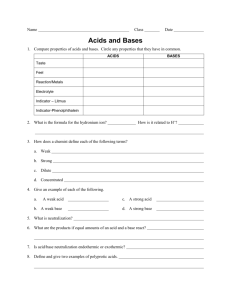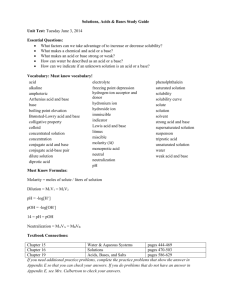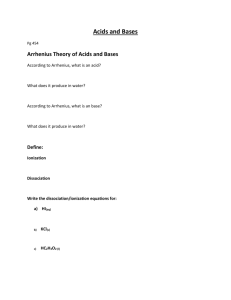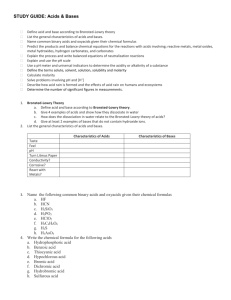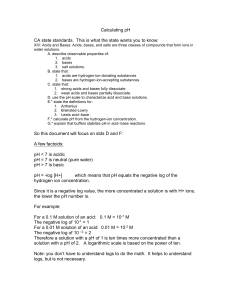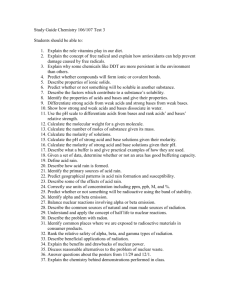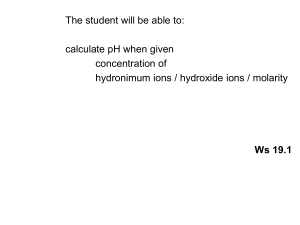Acids and Bases Review Sheet: Chemistry Concepts
advertisement
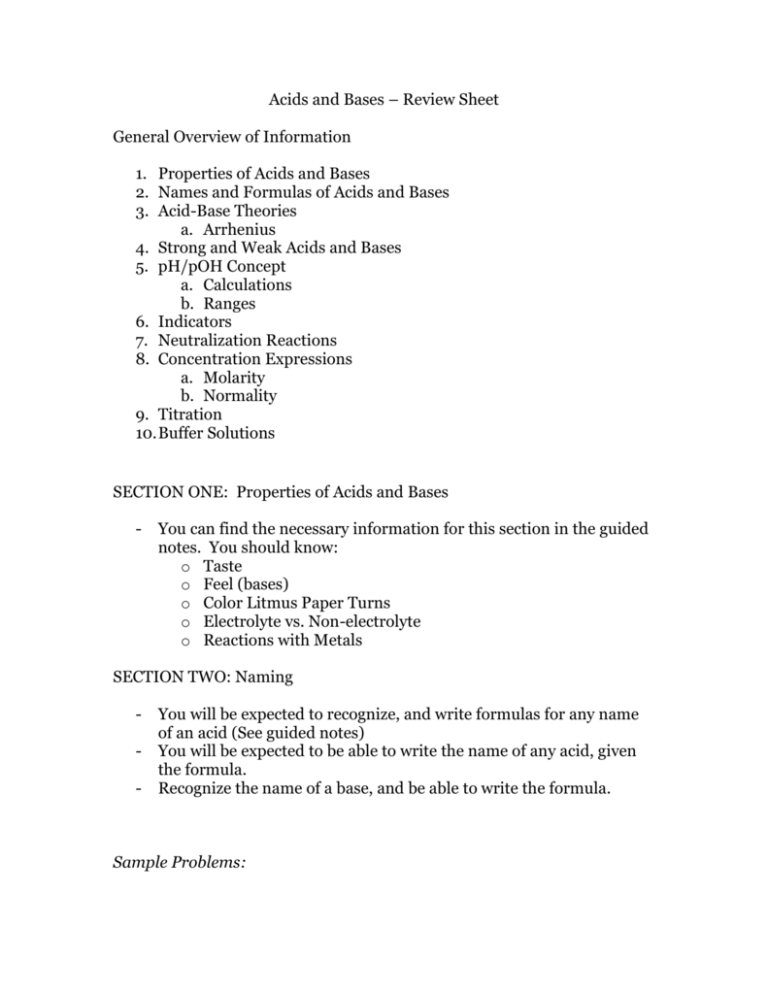
Acids and Bases – Review Sheet General Overview of Information 1. Properties of Acids and Bases 2. Names and Formulas of Acids and Bases 3. Acid-Base Theories a. Arrhenius 4. Strong and Weak Acids and Bases 5. pH/pOH Concept a. Calculations b. Ranges 6. Indicators 7. Neutralization Reactions 8. Concentration Expressions a. Molarity b. Normality 9. Titration 10. Buffer Solutions SECTION ONE: Properties of Acids and Bases - You can find the necessary information for this section in the guided notes. You should know: o Taste o Feel (bases) o Color Litmus Paper Turns o Electrolyte vs. Non-electrolyte o Reactions with Metals SECTION TWO: Naming - You will be expected to recognize, and write formulas for any name of an acid (See guided notes) You will be expected to be able to write the name of any acid, given the formula. Recognize the name of a base, and be able to write the formula. Sample Problems: Name the following Acids: Name the following Bases: HNO2 H2SO4 HCl HBr HClO NaOH Ca(OH)2 Mg(OH)2 KOH Write the formula: Nitric Acid Hydroiodidic Acid Phosphoric Acid Acetic Acid Write the formula: Sodium Carbonate Barium Hydroxide Lithium Hydroxide SECTION THREE: Acid- Base Theories 1. Arrhenius a. Know how he defined acids and bases (Guided Notes) b. Be able to tell whether something is an Arrhenius acid/base c. Understand the terms monoprotic, diprotic, triprotic, and polyprotic. SECTION FOUR – Strong Acids and Bases 1. Be able to explain what the difference is between a strong acid (base) and a weak acid (base) 2. Relationship between strength and conjugate acid/base pairs. 3. Relationship between strength and conductivity SECTION FIVE: pH/pOH concept 1. Know the definition of pH and pOH 2. Know the range of pH and be able to identify a substance as an acid or a base based on its pH 3. Be able to calculate pH and pOH from concentration, and vice versa. Sample Problems 1. If a soap has a hydrogen ion concentration of 2 x 10-6M, what is the pH of that solution? The pOH? Is the substance an acid or a base? 2. What is the hydrogen ion concentration and hydroxide ion concentration of a solution with a pH of 2.3? Is the substance an acid or a base? 3. What is the hydrogen ion concentration of a sample of phosphoric acid that has a pH of 4.9? SECTION SIX: Indicators 1. Be able to define what an indicator is 2. Explain how we used indicators in class 3. Give examples of some common indicators SECTION SEVEN: Neutralization Reactions 1. Be able to write the products of neutralization reactions 2. Understand what the word equivalent means Sample Problems: 1. Write the complete neutralization reaction for nitrous acid reacting with potassium hydroxide. 2. Write the complete balanced equation for the neutralization of phosphoric acid with calcium hydroxide. SECTION EIGHT: Concentration Expressions 1. Be able to define molarity and normality 2. Be able to convert from molarity to normality, and vice versa 3. Be able to do dilution problems related to molarity. Sample Problems: 1. How many grams of copper sulfate pentahydrate CuSO4 . 5H2O will be needed to make 75 mL of a 0.250M solution? 2. How many kilograms of sucrose C12H22O11 will be needed to make 3.50 L of a 1.15 M solution? 3. What is the molar concentration of a solution that contains 0.0750 moles of NaHCO3 in a volume of 115 mL? 4. If a solution has 3.0 moles of solute in 2 L of solution, what is its molar concentration? How many moles would there be in 350 mL of solution? 5. Describe in your own words how you would prepare 1.00 L of a 0.85 M solution of formic acid HCO2H. 6. What is the molarity of a sulfuric acid solution which contains 5.4 grams of sulfuric acid in 250 mL of water? What is the Normality? 7. What is the molarity of a potassium hydroxide solution which contains 0.94 moles of potassium hydroxide in 450 mL of water? What is the normality? SECTION NINE: Titrations 1. Understand why we do titrations 2. Be able to describe the process of doing a titration 3. Do the calculations in order to figure out the unknown concentration of a substance. Sample Problems: 1. In the titration of 35 mL of liquid drain cleaner containing NaOH, 50 mL of 0.4M HCl must be added to reach the equivalence point. What is the molarity of the base in the cleaner? 2. Calculate how many milliliters of 0.25 M Ba(OH)2 must be added to titrate 46 mL of 0.40 M HClO4. 3. A 15.5 mL sample of 0.215M KOH was titrated with an acetic acid solution. It took 21.2 mL of the acid to reach the equivalence point. What is the molarity of the acetic acid solution? 4. A 20 mL sample of an HCl solution was titrated with 27.4 mL of a standard solution of Ba(OH)2. The concentration of the standard is 0.0154 M. What is the molarity of the HCl? SECTION TEN: Buffer Solutions 1. 2. 3. 4. Know the definition of a buffer solution. What is it made of? What does it do? Where can we find buffers in everyday life?
